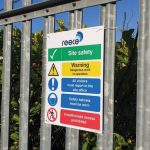It is a legal requirement for employers and responsible persons to ensure the correct health and safety signs are in place anywhere in the workplace where there may be a significant risk in terms of health and safety, either to employees or to the general public.
The Safety Signs and Signals Regulations 1996 outlines the need for all workplaces to implement appropriate health and safety signage relating to safety matters and messages, following established rules which means the messages are easily recognisable and informative.
These regulations apply to all places of work covered by the Health and Safety at Work Act 1974, which in turn governs the regulation and enforcement of workplace safety legislation. All employers have a duty of care in terms of implementing the regulations.
At Reece Safety, we offer a comprehensive range of UK-approved safety signs in different materials and sizes to match individual applications in line with health and safety regulations. We specialise in signage for LOTO (Lock Out, Tag Out) systems to prevent accidental start-up of machinery and equipment, as well as a ‘Design Your Own Sign’ service for specific environments and applications
Standardisation of signage
Making sure that everyone in the workplace remains safe demands a standardisation of appropriate signage, capable of crossing language barriers and country borders to ensure the information relayed is clear to all.
BS EN ISO 7010 was introduced to achieve this standardisation in terms of the appearance and information given on safety signs in workplace locations and premises. This standard is applied both in the UK and internationally to provide consistency in terms of messaging about health and safety dangers and hazards as well as other important information playing a role in keeping people safe.
Categories of safety signs and signals
The EC Safety Signs Directive 92/58/EEC came into force for all European Union countries back in 1992. In the UK it was implemented via Health and Safety (Safety Signs and Signals Regulations) 1996. Signage falls into several key categories.
Prohibition signs
A prohibition sign is always circular in shape and red in colour with a white background and a red crossbar at a 45-degree angle, complete with a black pictogram depicting the prohibited activity.
These signs are ‘Do Not’ commands prohibiting individual activities considered detrimental to safety. Common examples include ‘No Smoking’ and other instructional information, such as not using water to extinguish a fire.
Warning signs
Warning signs are yellow in colour and triangular in shape, with black symbols or accompanying text outside the warning triangle.
These signs are used to depict a warning of significant potential risk, providing relevant information on potential hazards in the area.
Mandatory signs
Mandatory signs are blue in colour and circular in shape, carrying a symbol or relevant text in white.
These signs provide instructions on actions designed to contribute towards the safety of employees and visitors to the workplace. Typical examples include compulsory instructions regarding the wearing of hard hats, eye protection and protective footwear.
Safe condition signs
Safe condition signs are green in colour and rectangular in shape, bearing text or symbols in white.
They are usually used to indicate the location of safety equipment and safe escape routes in the event of fire or other emergency.
Fire equipment signs
Fire equipment signs are rectangular and are predominantly red with white text or symbols.
Fire safety signs are used to indicate the location of fire alarm activation points and fire fighting equipment.
Fire instruction notices
Instructions on what to do in the event of a fire appear as white text on a blue background in line with the requirements of ‘mandatory’ signs. Because they usually carry more text than standard mandatory signs, they are usually rectangular.
In some cases, a ‘general mandatory’ white exclamation mark on a blue circle may accompany the fire instruction sign.
Supplementary information signs
Supplementary health and safety information signs are rectangular and may be predominantly green, red or yellow dependent upon content, with either white or black text or pictograms.
Familiar examples include the extensive range of coronavirus and social distancing information signs.
Colours and meanings of safety signs
The colours selected for safety signs have been chosen based on tried and tested psychological reactions and responses.
Yellow
Yellow is a striking colour and is one of the first colours visible to the human eye, so its use for warnings and hazard alerts is clear.
Yellow warning signs indicate specific dangers within the workplace, attracting immediate attention and acting as an effective caution. Yellow warning signs include high voltage and, trip hazards.
Red
Red is commonly associated with danger, so this colour has been chosen for prohibition signs. Red is also used commonly for fire safety signs and fire fighting equipment locations. This colour has a psychological association with danger, which is why it is used as a warning sign.
Blue & White
Blue is seen more as an advisory colour than a cautionary colour, which is why it is used for mandatory signs to indicate advice and courses of action. Blue has been the colour for mandatory signs for many years and carries an inherent association with instruction and advice.
Green
Green is usually viewed as the colour for permission and safety, which is why it is the chosen colour for signs for first aid equipment and fire exits or emergency exits and exit routes, indicating ‘safe to proceed’.
What happens if I don't provide safety signs?
It is a legal requirement to comply with the Health & Safety Act and the Health & Safety (Safety Signs and Signals) Regulations 1996, which explain the mandatory use of health and safety signage and what employers need to provide to reduce risks.
It is the responsibility of the employer or dutyholder to recognise and understand risks and hazards in the workplace and act the mitigate these by making people aware of work regulations. If you fail to provide adequate and compliant signage in terms of safety signs and signals, you could be subject to penalties from HSE (Health and Safety Executive). Action can be taken against companies as entities, managers and anyone designated as a ‘responsible person’ or ‘dutyholder’ within a workplace.
However, the most important consideration here is that these regulations have been developed and implemented to prevent injury in the workplace. Compliance helps ensure that employees benefit from a safe and well-regulated working environment.
What's the minimum expectation of an employer?
Employers are expected to take the time to understand the range of safety signs and colour coding so they can implement these correctly within their workplaces in terms of health and safety.
Risks will vary significantly; a construction site is potentially a far more hazardous environment than standard office premises. However, both have their requirements in terms of standardised signage, from indications of emergency exits and fire equipment to the requirements for personal protective equipment (PPE).
Employers are encouraged to avoid using a proliferation of signs where they may not be required, to avoid confusion and information overload. Safety signs do not need to be used if they will not reduce any risks or if there is not a significant risk. A simple risk assessment can be used to identify relevant health and safety requirements. Find out more about where appropriate signs are required and where they are not needed on the Health and Safety Executive website.
Specific risks and signs
Reece Safety specialises in the supply of electrical safety signs in conjunction with LOTO procedures, providing a constant reminder of the need to lock out equipment, machinery, engineering controls and power supplies before commencing maintenance or remedial work. These signs and tags play an important part in the LOTO system.
LOTO systems follow the general health and safety signage guidelines in terms of colour identification, with voltage labels using the triangular yellow with black lettering format found across the industry.
Examples of LOTO-related safety signs include the following:-
- Do Not Operate
- Do Not Start
- Maintenance In Progress
All safety signs, including LOTO products, are available ex-stock. Available materials include self-adhesive vinyl, magnetic material, rigid plastic, 5mm Foamex and aluminium composite panels.
Design your own safety sign service
Reece Safety also provides a ‘Design your own safety sign’ service, where you can choose your design, layout and material. Simply select the size, material and information you require then call or email us for a quotation or further information. We can also add your logo to standard signs which greatly reinforces your Corporate image standards.
In Summary
Installing the right health and safety signs plays an important role in your business’s Health and Safety Regulations processes. At Reece Safety, we carry extensive stocks of compliant signage products, in a wide range of sizes and materials, available for immediate despatch.
Browse the range today or call us to discuss our bespoke design service.
 UK
UK US
US










